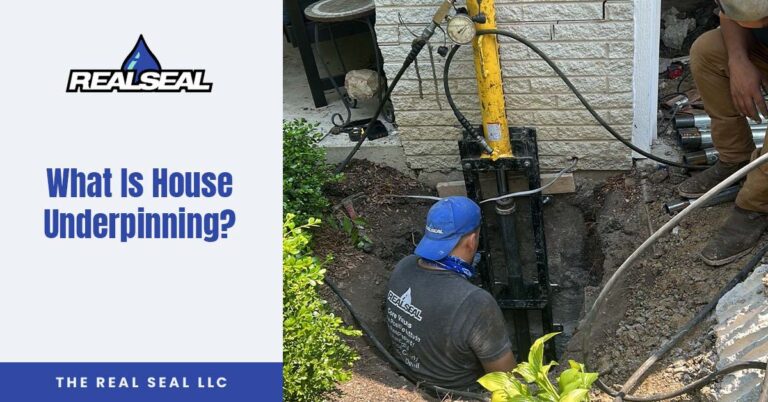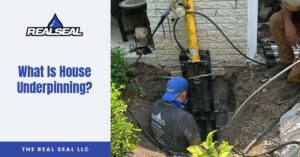Looking for information about house underpinning? If so, you’ve landed on the right page because that’s what we’re going to cover in this short article. We’ll go over what house underpinning is, how it’s performed, why a house might need underpinning, and more.
What Is House Underpinning?
House underpinning is a repair solution that improves a foundation’s stability and integrity by extending it down to soil that can adequately support it.
House underpinning is usually necessary when the existing foundation has been compromised. Underpinning helps to increase the load-bearing capacity of the foundation, thereby mitigating the risk of foundation failure and minimizing the potential for severe structural damage to the building.
Different methods and materials may be used for underpinning depending on the soil type, location, age of the building, and other relevant factors. Typically, underpinning involves excavating the soil around the existing foundation and inserting a series of support structures – such as push or helical piers – to reinforce the foundation.
House underpinning will ensure your home’s long-term safety and stability, particularly in soft or unstable soil conditions, even if there are issued with water seepage through the foundation.
Why Houses Sometimes Need Underpinning
A house will usually need underpinning when the original foundation is unstable due to differential settlement (i.e. when the foundation is settling into the ground unevenly).
So, the question is, what causes differential settlement?
Differential settlement can be caused by various things, including the following:
- Soil that contains a high percentage of clay. This type of soil is called “expansive” because it expands as it soaks up moisture and then shrinks as it releases moisture and dries out. This swelling and shrinking creates movement in the ground under the foundation and can eventually result in differential settlement.
- Earthquakes or other natural disasters that cause the soil to shift or settle
- Erosion-prone soil can also result in differential settlement if erosion causes voids to form under the foundation.
- Changes in the design or use of the building that place greater demands on the foundation.
- The presence of tree roots or other factors that can cause the soil to compact or erode.
Underpinning using push or helical piers is a relatively quick and minimally-invasive repair. Underpinning can be a costly undertaking, but it’s sometimes necessary to ensure the continued stability and safety of a building. By strengthening the foundation, underpinning can help to prevent further structural damage and extend the life of a building. It can also be a good investment for homeowners, increasing the value of their property and protecting against potential future damage.
How Is House Underpinning Done?
Resistance Push Piers
One of the most commonly utilized methods for house underpinning is resistance push piers. Push piers are installed beneath the foundation and are used to stabilize the building’s structure. The piers are driven into the ground under the foundation until they reach load-bearing soil, and then synchronized hydraulic jacks are used to lift the foundation.
Helical Piers
Another effective method of house underpinning is the use of helical piers. These piers are specially designed steel shafts that look something like giant corkscrews. They’re turned into the ground until they reach a stable soil layer. The unique helix shape of the piers provides an excellent grip, preventing them from moving or shifting once installed. Helical piers are especially useful for buildings constructed on slopes or hillsides. In this case, they would be called helical tiebacks.
Drilled Concrete Piers
Drilled concrete piers are another solution to foundation problems. This process involves drilling straight down into the ground until it reaches a stable layer of soil or bedrock and then filling the hole with concrete.
Slab Piers
Slab piers are sometimes used when the foundation is supported by a concrete slab instead of a basement or crawl space. Instead of being installed around the outside of the foundation, slab piers are driven through the slab and into the underlying soil.
Signs Your Home’s Foundation Might Need House Underpinning
As a homeowner, knowing the signs indicating your home’s foundation may require house underpinning is essential. These commonly include the following:
- Cracks in the walls, floors, or ceilings. These cracks aren’t merely cosmetic and will typically widen over time.
- Doors and windows that have difficulty opening or closing.
- Stair step cracks in brick or masonry.
- Uneven floors.
- Bowed foundation walls.
- Chimneys or porches that are pulling away from the house.
- Torn wallpaper. This could indicate the wall behind the wallpaper is cracked.
- Moldings that are separating from the wall or ceiling.
- Diagonal cracks from the corners of doors and windows.
If you notice any of these warning signs, it’s important to take action sooner rather than later. Contact a foundation repair professional and ask for an inspection. If you wait, it will lead to more extensive damage and increase the cost of repairs.
How Much Does House Underpinning Cost?
Because house underpinning is a complex process requiring specialized equipment and expertise, it’s not inexpensive. The cost of underpinning depends on various factors, such as the property’s location (some regions of the country are more expensive than others), the severity of the damage, the size and type of foundation, and the depth of the underpinning required.
In general, the average cost of underpinning ranges from $2,000 to $3,500 per pier. The cost can go up for complex projects that require extensive underpinning or involve larger structures with more significant foundation issues. The cost of underpinning can also vary depending on the type of underpinning method used. For instance, concrete underpinning is a more expensive technique than underpinning using push or helical piers.
Underpinning is not a DIY project
It’s crucial to note that underpinning is not a DIY project. Among other things, it requires specialized equipment and a lot of expertise. Therefore, hiring a licensed, reputable, and experienced foundation repair contractor for the underpinning project is essential to ensure that the work is done correctly and safely.
If you think your Chicagoland home might need house underpinning, contact The Real Seal today and schedule a foundation evaluation. If we find a problem, we’ll give you a repair estimate.






